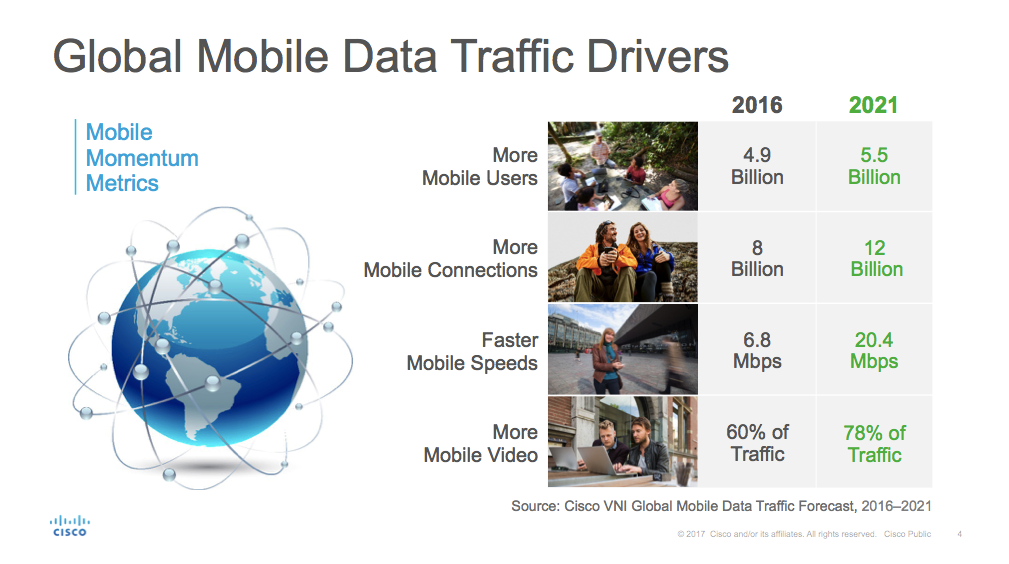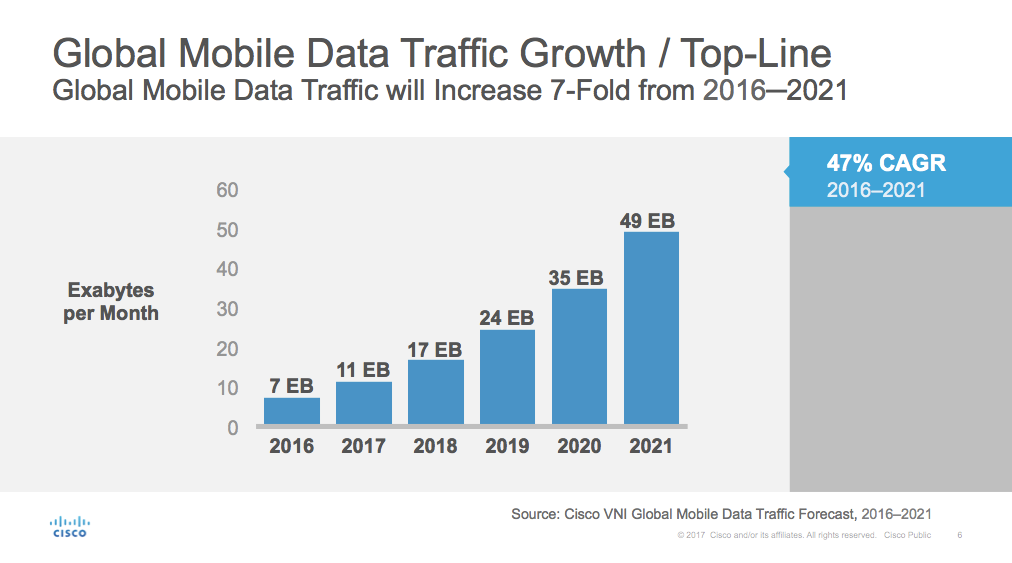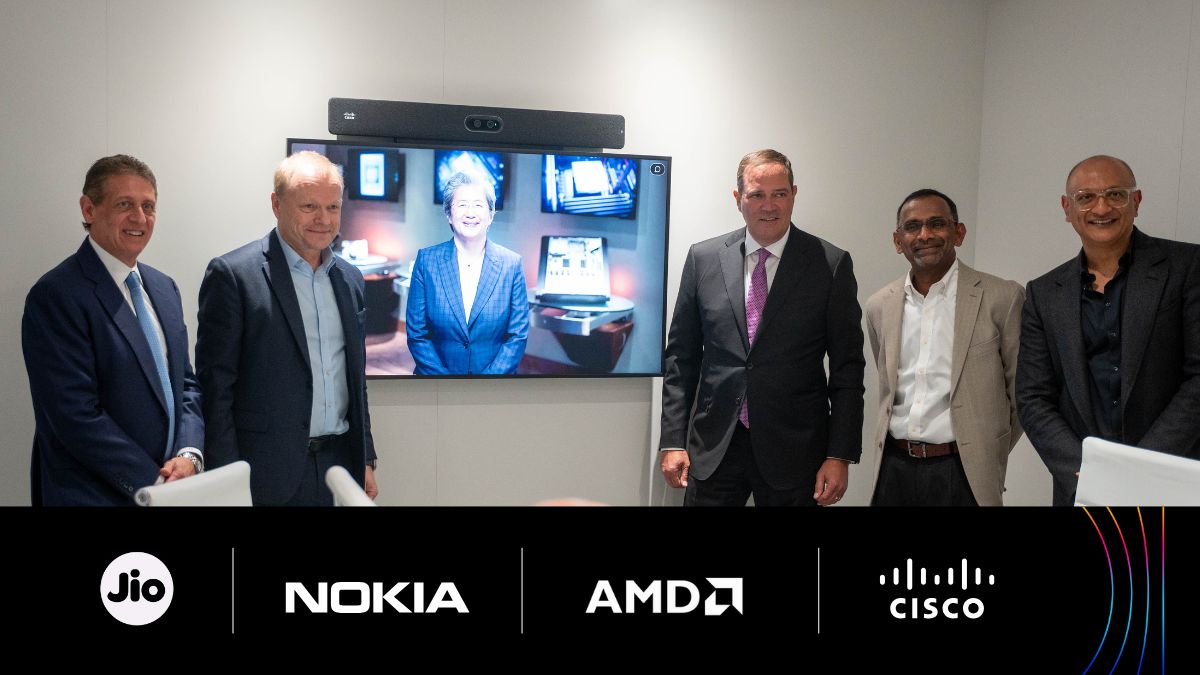SAN JOSE, Calif. – February 7, 2017—By 2021, more members of the global population[1] will be using mobile phones (5.5 billion) than bank accounts (5.4 billion), running water (5.3 billion), or landlines (2.9 billion), according to the 11th annual Cisco Visual Networking Index™ (VNI) Global Mobile Data Traffic Forecast (2016 to 2021). Strong growth in mobile users, smartphones and Internet of Things (IoT) connections as well as network speed improvements and mobile video consumption are projected to increase mobile data traffic seven-fold over the next five years.
By 2021, Cisco projects mobile data traffic to reach the following milestones:
- Mobile data traffic to represent 20 percent of total IP traffic—up from just 8 percent of total IP traffic in 2016.
- 1.5 mobile devices per capita. Nearly 12 billion mobile-connected devices (up from 8 billion and 1.1 per capita in 2016), including M2M modules.
- Mobile network connection speeds will increase threefold from 6.8 Mbps in 2016 to 20.4 Mbps by 2021.
- Machine-to-machine (M2M) connections will represent 29 percent (3.3 billion) of total mobile connections—up from 5 percent (780 million) in 2016. M2M will be the fastest growing mobile connection type as global Internet of Things (IoT) applications continue to gain traction in consumer and business environments.
- 4G will support 58 percent of total mobile connections by 2021—up from 26 percent in 2016 and will account for 79 percent of total mobile data traffic.
- The total number of smartphones (including phablets) will be over 50 percent of global devices and connections (6.2 billion)—up from 3.6 billion in 2016.
The explosion of mobile applications and adoption of mobile connectivity by end users is fueling the growth of 4G, soon to be followed by 5G growth. Cisco and other industry experts anticipate large-scale deployments of 5G infrastructures to begin by 2020. Mobile carriers will need the innovative speed, low latency, and dynamic provisioning capabilities that 5G networks are expected to deliver to address not just increasing subscriber demands but also new services trends across mobile, residential, and business markets. Cisco forecasts that 5G will account for 1.5 percent of total mobile data traffic by 2021, and will generate 4.7 times more traffic than the average 4G connection and 10.7 times more traffic than the average 3G connection.
“With the proliferation of IoT, live mobile video, augmented and virtual reality applications, and more innovative experiences for consumer and business users alike, 5G technology will have significant relevance not just for mobility but rather for networking as a whole,” said Doug Webster, vice president of service provider marketing. “As a result, broader and more extensive architectural transformations involving programmability and automation will also be needed to support the capabilities 5G enables, and to address not just today’s demands but also the extensive possibilities on the horizon.”
Additional Key Mobile Data Traffic Projections and Forecasted Trends:
1. By 2021, global mobile data traffic will reach 49 exabytes per month or 587 exabytes annually).
- The forecast annual run rate of 587 exabytes of mobile data traffic for 2021 is equivalent to:
- 122 times more than all global mobile traffic generated just 10 years ago in 2011
- 131 trillion images (e.g., MMS)
2. High growth for live video on mobile
- Mobile video will increase 8.7-fold from 2016 to 2021 and will have the highest growth rate of any mobile application category. Mobile video will represent 78 percent of all mobile traffic by 2021.
- Live mobile video will grow 39-fold from 2016 to 2021. Live mobile video will represent 5 percent of total mobile video traffic by 2021.
3. Growth in Virtual Reality (VR) and Augmented Reality (AR)
- VR immerses users in a simulated environment. AR is an overlay of technology on the real world.
- Applications such as virtual reality (VR) are adding to the adoption of wearables such as headsets. VR headsets are going to grow from 18 million in 2016 to nearly 100 million by 2021— a fivefold growth.
- Globally, VR traffic will grow 11-fold from 13.3 petabytes/month in 2016, to 140 petabytes/ month in 2021.
- Globally, AR traffic will grow 7-fold between 2016 and 2021, from 3 petabytes/month in 2016 to 21 petabytes /month in 2021.
4. Global connected wearable devices driving M2M growth
- Cisco estimates there will be 929 million wearable devices globally, growing nearly threefold from 325 million in 2016.
- Globally, the number of wearable devices with embedded cellular connections will reach 69 million in number by 2021—up from 11 million in 2016.
5. Mobile data traffic offload to Wi-Fi networks
- In 2016, 60 percent of total mobile data traffic was offloaded; by 2021, 63 percent of total mobile data traffic will be offloaded.
- In 2016, monthly offload traffic (10.7 EB) exceeded monthly mobile/cellular traffic (7.2 EB).
- Globally, total public Wi-Fi hotspots (including homespots) will grow six-fold from 2016 (94.0 million) to 2021 (541.6 million).
- Wi-Fi traffic from both mobile devices and Wi-Fi-only devices together will account for almost half (49 percent) of total IP traffic by 2020, up from 42 percent in 2015.
6. Regional mobile data traffic growth (2016 – 2021)
- The Middle East and Africa will have 12-fold growth
- (2016: 7.3 exabytes/year; 2021: 88.4 exabytes/year)
- Asia-Pacific will have 7-fold growth
- (2016: 37.3 exabytes/year; 2021: 274.2 exabytes/year)
- Latin America will have 6-fold growth
- (2016: 5.4 exabytes/year; 2021: 34.8 exabytes/year)
- Central and Eastern Europe will have 6-fold growth
- (2016: 11.1 exabytes/year; 2021: 63.0 exabytes/year)
- Western Europe will have 6-fold growth
- (2016: 8.8 exabytes/year; 2021: 50.3 exabytes/year)
- North America will have 5-fold growth
- (2016: 16.9 exabytes/year; 2021: 76.8 exabytes/year)
Cisco Mobile VNI Forecast Methodology
The Cisco® VNI Global Mobile Data Traffic Forecast (2016‑2021) relies upon independent analyst forecasts and real-world mobile data usage studies. Upon this foundation are layered Cisco's own estimates for mobile application adoption, minutes of use and transmission speeds. Key enablers such as mobile broadband speed and device computing power are also factored into Cisco mobile VNI projections and findings. A detailed methodology description is included in the complete report (see link below).
Editor's Notes
Cisco also welcomes press, analysts, bloggers, service providers, regulators and other interested parties to use and reference our research with proper attribution, such as "Source: Cisco Visual Networking Index Global Mobile Data Traffic Forecast Update, 2016‑2021."
Cisco defines the following terms:
- Cellular Traffic: comes from a cellular or radio network connection—2G, 3G, 4G and 5G.
- Wi-Fi Offload Traffic: refers to traffic from dual mode devices (supports cell and Wi-Fi connectivity, excluding laptops) over Wi-Fi/small cell networks. Offloading occurs at the user/device level when one switches from a cellular connection to Wi-Fi/small cell access.
- Fixed/Wi-Fi Traffic: comes from a wireless connection enabled by some fixed network source, such as a residential Wi-Fi router or public hotspot.
Video and Images
- Infographic: Cisco Visual Networking Index: Global Mobile Data Traffic Forecast Update (2016-2020)
- Register to the Webinar to learn more: Americas/Europe or Asia
Additional Supporting Resources
- Cisco Visual Networking Index home page
- Cisco Visual Networking Index Mobile Data Traffic blog post: “Five key surprises from this year’s forecast” "
- Read the complete Cisco Visual Networking Index: Global Mobile Data Traffic Forecast Update, 2016–2021 white paper.
- Cisco Visual Networking Index: Global Mobile Data Traffic Forecast Q&A, 2016–2021
- Launch the Mobile VNI Highlights Tool
- Use the VNI Widget
- Interact with us on our Communities page
- For more information about Cisco's service provider news and activities visit the SP360 Blog or follow us on Twitter @CiscoVNI.
Cisco (NASDAQ: CSCO) is the worldwide technology leader that has been making the Internet work since 1984. Our people, products, and partners help society securely connect and seize tomorrow's digital opportunity today. Discover more at newsroom.cisco.com and follow us on Twitter at @Cisco.
Cisco and the Cisco logo are trademarks or registered trademarks of Cisco and/or its affiliates in the U.S. and other countries. A listing of Cisco's trademarks can be found at www.cisco.com/go/trademarks. Third-party trademarks mentioned are the property of their respective owners. The use of the word partner does not imply a partnership relationship between Cisco and any other company.
[1] Global population in 2021 will be approximately 7.8 billion people according to United Nations’ estimates.








